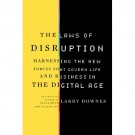I dashed off a quick analysis of the Bilski decision for CNET yesterday (see “Supreme Court Hedges on Business Method Patents”), a follow-up to a piece I wrote for The Big Money when the case was argued last fall. (See “Not with my Digital Economy, You Don’t.”)
The decision was a surprise for me. I had fully expected the Court to reject outright the experiment in granting patents to paper-and-pencil business methods launched by the Federal Circuit in 1998 with the State Street decision. Especially since the Federal Circuit itself, in its rejection of Bilski’s application, had all but dismissed State Street as the disaster most businesses—even businesses who have benefited from business method patents–know it to be.
Indeed, as an experiment (in hubris, perhaps), I actually drafted my article over the weekend, even making up quotes I thought might appear in the majority opinion, which I presumed would be written by retiring Justice John Paul Stevens.
Here’s the lede from the piece, which I headlined “Supreme Court Ends Era of Business Method Patents”:
“In a dramatic change in U.S. law, the U.S. Supreme Court today rejected the patenting of business methods, casting doubt on the viability of [XX,XXX] such patents granted by the U.S. Patent Office since 1998. The sprawling opinion by a divided Court also cast doubts on the long-term viability of patents for most software products. (The Court’s XXX hundred page opinions are available here [link].)”
Needless to say, I got it wrong, and when the actual decision was released yesterday morning at 11 AM Eastern time, I had to start over.
In the end, the majority opinion was a mere 16 pages. It basically did nothing to change patent law or to settle enormous and mushrooming uncertainties, both for business methods and, more generally, for software applications.
Justice Kennedy’s opinion explicitly refused to endorse or reject State Street, nor did it foreclose future efforts by the Federal Circuit to find some way to reign in the madness of patents for reserving office bathrooms, exercising cats and, my favorite, for the process of obtaining a patent—madness for which the Federal Circuit itself is fully to blame.
Justice Stevens, joined by Justices Breyer, Sotomayor and Ginsburg, would have gone much farther, as evidenced by his much-longer concurring opinion, which had all indications of having started life as the majority opinion. Stevens has made no secret of his disdain for the judicial expansion of patent protection over the years. Had his opinion been the majority I would have had to make very few changes to the earlier version of my article.
Stevens Loses his Majority
So what happened?
I think it’s pretty clear reading all the opinions together that Stevens lost his majority when he and Justice Kennedy couldn’t agree on the breadth of Stevens’ rejection of recent judicial expansions of patentability. At that point the other Justices who wanted to deny Bilski his patent but didn’t want to go as far as Stevens had a majority. As the swing vote, Kennedy was asked to write the new majority opinion, such as it is.
With the loss of Kennedy, Stevens lost his last chance to have a big impact on the Court’s intellectual property jurisprudence. As Timothy B. Lee lovingly details in an Ars Technica article updated yesterday, Stevens had a long history of writing important decisions that protected nascent technology industries from the excesses of patent and copyright maximalists.
Perhaps most important among those cases was Betamax, in which Stevens stretched the doctrine of fair use to hold that Sony was not responsible for widespread unauthorized time-shifting of television programming by users of the VCR devices it sold. The Betamax fight was a highlight of a battle that is perhaps 100 years old or more between content owners and technology providers. The VCR, much as every innovation since in digital encoding has done, sent Hollywood into apoplexy. Echoing ongoing hysteria by content owners over the continued advance of Moore’s Law, the MPAA’s Jack Valenti famously said in 1982 that “the VCR is to the American film producer and the American public as the Boston strangler is to the woman home alone.”
Like the Viacom v. YouTube case I wrote about the other day, by the way, one way of looking at the result in Betamax is that it highlights the institutional limits of the judicial branch, particularly in crafting, supervising, and enforcing remedies. The studios in Betamax, and Viacom today, implicitly or explicitly want the offending technology banned. But with millions of Betamaxes already in American homes by the time the case reached the Supreme Court, how exactly would such a remedy have been operationalized? How could YouTube, likewise, comply with an a priori rule of no infringing content without simply shutting down?
Where Kennedy Feared to Tread
Of course I don’t have any inside knowledge that Kennedy bolted from Stevens’ Bilski opinion, but I’m pretty sure the truth is something close to that. My explanation would also explain why it took so long to issue such a short opinion—for Bilski was argued in the fall, and only released on the very last day of the 2010 term. If Stevens initially had a majority that fell apart, of course, that would have left Kennedy to start later in the game than if he knew all along he was writing for the majority.
There are also some interesting clues in those portions of Justice Kennedy’s decision that Justice Scalia refused to join (those parts only got four votes, so they don’t stand as binding precedent). It’s been clear since 2006 that Kennedy was one of the Justices skeptical of business method patents. In his concurrence in eBay Inc. v. MercExchange, L. L. C., 547 U. S. 388, 397 (2006), a case dealing with patent injunctions, Kennedy noted that many patents on business methods are of “suspect validity,” a concern he repeats in Bilski.
But, it turns out, Kennedy’s disdain for business methods doesn’t necessarily apply to the closely-related problem of patents for software. Had the Supreme Court endorsed the Federal Circuit’s proposed “machine-or-transformation” test, not only would business method patents be out but so too would most if not all patents for software. Kennedy at least was not willing to go that far.
Let’s back up a bit. The “machine-or-transformation” test, the basis on which the Federal Circuit rejected Bilski’s application, derives from earlier Supreme Court patent cases (some of them quite old) that attempted to deal with the growing convergence of inventions based on information technology with those of the more traditional variety. It states that for a process patent to be considered in the first place, it must as a threshold matter describe a process that is either “tied to a particular machine or apparatus,” or one that “transforms a particular article into a different state or thing.”
The “machine” part of the test comes from an early software case, in which the applicant attempted to patent the basic algorithm for translating binary representation into binary arithmetic. The Supreme Court rejected that claim on the basis that algorithms or “mental steps” were too abstract to be patented, a sensible limit given the potential sweep such patents could have in emerging fields.
The “transformation” part of the test comes from a later case, in which a famous algorithm was translated into software that opened molds when environmental conditions (temperature, pressure) indicated the material inside had properly cured. Here the patent was allowed, on the basis that the process described effected a transformation not of numbers on a piece of paper but of some actual, constrained physical article. It was not the algorithm itself that was patented, in other words, but a very specific implementation.
If “machine-or-transformation” were applied as a threshold test for process patents, it’s clear that business methods would be out. For by definition they are not tied to a particular machine, nor does the execution of their steps affect change a particular article into a different state or thing. In most cases, the method can be applied mentally or with paper and pencil. When software is used, it is generally to automate the steps and to allow the method to be executed repeatedly and quickly.
Well, What About Software?
So how would software patents prevail had the Court adopted “machine-or-transformation”? As I wrote in Law 8 of The Laws of Disruption, most software patents would likely fail the test. First, most software patents are written for general purpose computers, and so would fail the particular machine test (probably—the meaning of “particular machine” has never really been explored since the 1972 case involving binary translation).
And what about “transformation”? All software, when executing, transforms a particular article (memory circuits) into a different state (on/off), but it can’t be that every piece of software is therefore eligible for a process patent. (As “written expression,” all but the simplest programs receive automatic protection under copyright for something close to 100 years.) Following the mold case, perhaps the Court would say that only software whose execution transforms something other than the computer’s internal circuitry itself would qualify. But that would limit the class of software eligible for patent protection to almost nothing.
So Kennedy is probably right to say that the “machine-or-transformation” test, if adopted as a threshold requirement for process patents, would “create uncertainty as to the patentability of software, advanced diagnostic medicine techniques, and inventions based on linear programming, data compression, and the manipulation of digital signals.”
To which many, including me, would say, “Good!” Given the automatic application of copyright to most software applications, one might ask why software needs patent protection at all. The long answer is quite long. The short answer is that it probably doesn’t.
Put another way, the granting of a 20-year monopoly for software puts a drag on the speed with which information technology can be developed and deployed, one that probably isn’t balanced with the additional innovation the availability of that monopoly encourages. And keeping that balance is the sole rationalization for creating the patent system in the first place.
But Justice Kennedy did not want to go that far, and, it seems, for much the same reason that Justice Stevens did: to protect emerging information technology industries. “[T]imes change,” writes Kennedy. “Technology and other innovation progress in unexpected ways.” It may be, according to Kennedy, that a simple rule like “machine-or-transformation” would strike the balance between protection and the public domain too far on the side of the latter. Or maybe not. “Nothing in this opinion,” he says, “should be read to take a position on where that balance ought to be struck.”
So, says Kennedy, again in a plurality section of his opinion, the Federal Circuit should search for a better way to control the patent tsunami created by State Street. How? Here’s a hint, though just barely, as to how such a test ought to be crafted to satisfy Justice Kennedy, if not Justice Roberts, Thomas, and Alito, who joined this paragraph of the opinion:
“[I]f the Court of Appeals were to succeed in defining a narrower category or class of patent applications that claim to instruct how business should be conducted, and then rule that the category is unpatentable because, for instance, it represents an attempt to patent abstract ideas, this conclusion might well be in accord with controlling precedent.”
Translation: I (we?) am not opposed to threshold tests that exclude business method patents. I just didn’t like the particular test the Federal Circuit came up with, because it probably leaves out software as well.
Is he Right?
On balance, I’m surprised to find myself agreeing with Justice Kennedy. The “machine-or-transformation” test had the salutary effect of eliminating business method patents, which, I suspect most of the Justices (certainly a majority) do not believe deserving of patent protection. It also had the effect, perhaps, of eliminating most software patents.
But Kennedy is right to say that “machine-or-transformation” would at a minimum cast great doubt on the viability of software patents. For that test, despite being derived from computer-related cases, doesn’t at all take into account the very nature of software. General purpose computers have revolutionized every aspect of business and life precisely because they are general purpose machines (or, to use the technical term, “virtual machines”). Through software, computing devices of all shapes and sizes can be transformed into millions of other, specific, machines, often simultaneously.
It’s probably better to say that some software applications do rise to the level of innovation necessary to sustain a patent. The “machine-or-transformation” test, however, would have given courts little guidance as to how to separate the truly novel and nonobvious (other necessary conditions of patentability) from the mundane. All software either passes or fails.
For Justice Kennedy, the possibility of over-exclusion was too high. For Justice Stevens, the possibility of over-inclusion was more dangerous.
Both are eager to create the right environment for continued innovation in information technology. In the end, they just couldn’t agree on where the risk was greatest.
What would be better? As Kennedy suggests, a different test that wouldn’t affect software patents would likely survive a future challenge. That would get rid of business method patents, certainly a good first step.
Then, the courts—or better, Congress—could take a separate and clear-headed look at the software patent problem.
To me, the best solution would be to undo the extension to software of both copyright (by Congress) and patent (by the courts), and to create instead a form of protection that is more limited, constrained, and constructed around the unique and indeed miraculous properties of the virtual machine. A specific form of protection for “Information Age” inventions.
No sense in describing that protection in any great detail now. The chances of that solution being implemented, needless to say, are too slim to be visible.
Postscript: What About Scalia?
One loose end in Bilski is the curious role played by Justice Scalia in the opinions. As noted, Scalia joined all of Justice Kennedy’s opinion other than the two sections expressing concern about the impact “machine-or-transformation” would have on software, or what Kennedy refers to repeatedly as inventions of “The Information Age.”
There’s no way to know why Scalia declined to join those sections (and, therefore, robbed them of precedential status), but one clue can be found in a second concurrence, this one by Justice Breyer, which Scalia joined in part.
Breyer begins by acknowledging his view that business methods are flat-out unpatentable. No surprise there—Breyer signed on to Stevens’ opinion, and has previously expressed grave doubts about business method patents in cases where the issue was raised but not decided.
Scalia joins Part II of Breyer’s opinion, which tries to summarize the points on which all nine Justices are, at the end of the day, in agreement. (All nine, of course, voted to affirm the Federal Circuit’s rejection of Bilski’s application. The only question had to do with the reasoning for that rejection.)
Breyer returns to the cases from which the Federal Circuit derived the “machine-or-transformation” test, and notes that “transformation is the clue to the patentability of a process claim that does not include particular machines.” (emphasis in original)
The error of the Federal Circuit, then, was to treat “machine-or-transformation” not as a test, but as “the exclusive test.” (emphasis in original) And “machine-or-transformation” is still a far better test, Breyer (with Scalia) goes on, than the much broader statement from State Street (“useful, concrete and tangible result”) that started this whole mess.
Here’s the kicker. Breyer and Scalia agree that “[t]o the extent that the Federal Circuit’s decision in this case rejected [the State Street] approach, nothing in today’s decision should be taken as disapproving of that determination.”
So, there you have it. Scalia doesn’t like State Street and doesn’t hate “machine-or-transformation.” But for some reason apparently not having to do with the impact of that test on the patentability of software, Scalia objected, like Kennedy, to Stevens’ willingness to adopt it as the threshold requirement for process patents.
Does that leave Scalia wanting more protection for software, or less?
Stay tuned!






